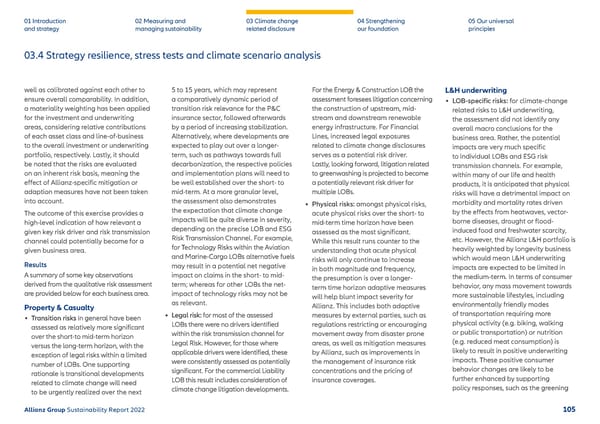03.4 Strategy resilience, stress tests and climate scenario analysis well as calibrated against each other to ensure overall comparability. In addition, a materiality weighting has been applied for the investment and underwriting areas, considering relative contributions of each asset class and line-of-business to the overall investment or underwriting portfolio, respectively. Lastly, it should be noted that the risks are evaluated on an inherent risk basis, meaning the effect of Allianz-specific mitigation or adaption measures have not been taken into account. 01 Introduction and strategy 02 Measuring and managing sustainability 03 Climate change r elated disclosure 04 Strengthening our f oundation 05 Our universal principles The outcome of this exercise provides a high-level indication of how relevant a given key risk driver and risk transmission channel could potentially become for a given business area. Results A summary of some key observations deriv ed from the qualitative risk assessment are provided below for each business area. Property & Casualty • Transition risks in general have been assessed as relatively more significant over the short-to mid-term horizon versus the long-term horizon, with the exception of legal risks within a limited number of LOBs. One supporting rationale is transitional developments related to climate change will need to be urgently realized over the next 5 to 15 years, which may represent a c omparatively dynamic period of transition risk relevance for the P&C insurance sector, followed afterwards by a period of increasing stabilization. Alternatively, where developments are expected to play out over a longer- term, such as pathways towards full decarbonization, the respective policies and implementation plans will need to be well established over the short- to mid-term. At a more granular level, the assessment also demonstrates the expectation that climate change impacts will be quite diverse in severity, depending on the precise LOB and ESG Risk Transmission Channel. For example, for Technology Risks within the Aviation and Marine-Cargo LOBs alternative fuels may result in a potential net negative impact on claims in the short- to mid- term; whereas for other LOBs the net- impact of technology risks may not be as relevant. • Legal risk: for most of the assessed LOBs there were no drivers identified within the risk transmission channel for Legal Risk. However, for those where applicable drivers were identified, these were consistently assessed as potentially significant. For the commercial Liability LOB this result includes consideration of climate change litigation developments. For the Energy & Construction LOB the assessment f oresees litigation concerning the construction of upstream, mid- stream and downstream renewable energy infrastructure. For Financial Lines, increased legal exposures related to climate change disclosures serves as a potential risk driver. Lastly, looking forward, litigation related to greenwashing is projected to become a potentially relevant risk driver for multiple LOBs. • Physical risks: amongst physical risks, acute physical risks over the short- to mid-term time horizon have been assessed as the most significant. While this result runs counter to the understanding that acute physical risks will only continue to increase in both magnitude and frequency, the presumption is over a longer- term time horizon adaptive measures will help blunt impact severity for Allianz. This includes both adaptive measures by external parties, such as regulations restricting or encouraging movement away from disaster prone areas, as well as mitigation measures by Allianz, such as improvements in the management of insurance risk concentrations and the pricing of insurance coverages. L&H underwriting • LOB-specific risks: for climate-change related risks to L&H underwriting, the assessment did not identify any overall macro conclusions for the business area. Rather, the potential impacts are very much specific to individual LOBs and ESG risk transmission channels. For example, within many of our life and health products, it is anticipated that physical risks will have a detrimental impact on morbidity and mortality rates driven by the effects from heatwaves, vector- borne diseases, drought or flood- induced food and freshwater scarcity, etc. However, the Allianz L&H portfolio is heavily weighted by longevity business which would mean L&H underwriting impacts are expected to be limited in the medium-term. In terms of consumer behavior, any mass movement towards more sustainable lifestyles, including environmentally friendly modes of transportation requiring more physical activity (e.g. biking, walking or public transportation) or nutrition (e.g. reduced meat consumption) is likely to result in positive underwriting impacts. These positive consumer behavior changes are likely to be further enhanced by supporting policy responses, such as the greening Allianz Group Sustainability Report 2022 105
 Sustainability Report 2022 | Allianz Page 105 Page 107
Sustainability Report 2022 | Allianz Page 105 Page 107